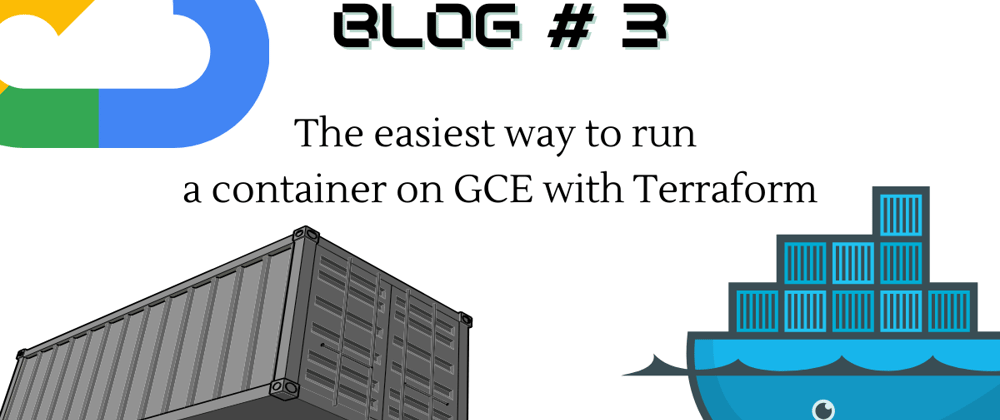Recently I developed a worker that would listen to published tasks through a database. For this sole purpose, I used Django Q. When I finished its development, I started wondering how I would enable it in production. As my whole stack is on GCP for personal projects, I found an exciting way to deploy it with Google Compute Engine using a container image. Let's see how we can do it pretty quickly with the help of Terraform.
Some limits you must be aware of before we start
There are some limitations that you should pay attention to before spending any time on this solution. These two, in particular, can bring trouble to you:
- You can only deploy one container for each VM instance. Consider Google Kubernetes Engine if you need to deploy multiple containers per VM instance.
- You can only deploy containers from a public repository or from a private Container Registry repository that you have access to. Other private repositories are not supported.
In our example, I'll use a private image from Container Registry, and for that, we'll need a user that can read and download it.
How to create a service account that can download images on Container Registry
You can create a service account with Terraform too, but let's stick with the command line. To make the account, you can issue the following:
gcloud iam service-accounts create custom-gce-dealer \
--display-name "Custom GCE Dealer"
You must check which storage is used for your container registry. Let's suppose it's artifacts.agrabah-project.appspot.com. Then you can execute the following command, using the generated ID for your service account:
gsutil iam ch \
serviceAccount:custom-gce-dealer@agrabah-project.iam.gserviceaccount.com:roles/storage.objectViewer \
gs://artifacts.agrabah-project.appspot.com
That's all we need to check out images from the container registry.
Terraform manifests
I've found a module that handles the metadata needed to set up the container configuration for the resource google_compute_instance. Let's use it to create our own module; thus, our main.tf file will not be immense and difficult to understand. First, let's start a project with the following structure:
root-folder-of-your-project/ <--- Main project
│
├── gce-with-container/ <--- Our custom module
| |
│ ├── main.tf
│ └── variables.tf
│
├── main.tf <--- We'll use gce-with-container here
├── terraform.tfvars <--- Values for what we defined in variables.tf
├── variables.tf <--- terraform.tfvars has the values for each defined variables
└── versions.tf <-- Here you will find the terraform block which specifies the required provider version and required Terraform version for this configuration
Custom module
The folder gce-with-container contains our custom module. I've checked all the examples available on terraform-google-container-vm to create my own. Let's see how it's defined the main.tf:
locals {
# https://www.terraform.io/docs/language/values/locals.html
instance_name = format("%s-%s", var.instance_name, substr(md5(module.gce-container.container.image), 0, 8))
env_variables = [for var_name, var_value in var.env_variables : {
name = var_name
value = var_value
}]
}
####################
##### CONTAINER SETUP
module "gce-container" {
# https://github.com/terraform-google-modules/terraform-google-container-vm
source = "terraform-google-modules/container-vm/google"
version = "~> 2.0"
container = {
image = var.image
command = var.custom_command
env = local.env_variables
securityContext = {
privileged : var.privileged_mode
}
tty : var.activate_tty
}
restart_policy = "Always"
}
####################
##### COMPUTE ENGINE
resource "google_compute_instance" "vm" {
name = local.instance_name
# gcloud compute machine-types list | grep micro | grep us-central1-a
# e2-micro / 2 / 1.00
# f1-micro / 1 / 0.60
# gcloud compute machine-types list | grep small | grep us-central1-a
# e2-small / 2 / 2.00
# g1-small / 1 / 1.70
machine_type = "f1-micro"
# If true, allows Terraform to stop the instance to update its properties.
allow_stopping_for_update = true
boot_disk {
initialize_params {
image = module.gce-container.source_image
}
}
network_interface {
network = var.network_name
access_config {}
}
metadata = {
gce-container-declaration = module.gce-container.metadata_value
}
labels = {
container-vm = module.gce-container.vm_container_label
}
service_account {
email = var.client_email
scopes = [
"https://www.googleapis.com/auth/cloud-platform",
]
}
}
I created some custom variables (see the file variables.tf) and a helper to make the configuration of environment variables easier (see locals.env_variables).
Main project
Our main.tf file in our root folder has the boilerplate part that configures the provider (see variables.tf and terraform.tfvars) and the module we created previously. I'm only using the variable custom_command because the container image I provided already has a CMD entry on its Dockerfile; thus, it must be overridden.
provider "google" {
project = var.project
credentials = file(var.credentials_file)
region = var.region
zone = var.zone
}
module "gce-worker-container" {
source = "./gce-with-container"
image = "gcr.io/${var.project}/jafar@sha256:6b71cebad455dae81af9fcb87a4c8b5bca2c2b6b2c09cec21756acd0f1ae7cec"
privileged_mode = true
activate_tty = true
custom_command = [
"./scripts/start-worker.sh"
]
env_variables = {
Q_CLUSTER_WORKERS = "2"
DB_HOST = "your-database-host"
DB_PORT = "5432"
DB_ENGINE = "django.db.backends.postgresql"
DB_NAME = "db_production"
DB_SCHEMA = "jafar_prd"
DB_USER = "role_jafar_prd"
DB_PASS = "this-is-my-honest-password"
DB_USE_SSL = "True"
}
instance_name = "jafar-worker"
network_name = "default"
# This has the permission to download images from Container Registry
client_email = "custom-gce-dealer@${var.project}.iam.gserviceaccount.com"
}
That's it! You can type terraform init at the root folder and then terraform apply followed by your confirmation. It's a good idea to access the created VM and check if everything is okay through the command docker logs.
If you see the container with the image gcr.io/gce-containers/konlet:v.0.11-latest, you don't have to worry 👀. It's the job responsible for downloading the one you configured 😅.
In this article I used Terraform v0.14.9. You can check the entire code out on GitHub. Don't forget to execute terraform destroy after your test! See you next time ✌.







Top comments (0)